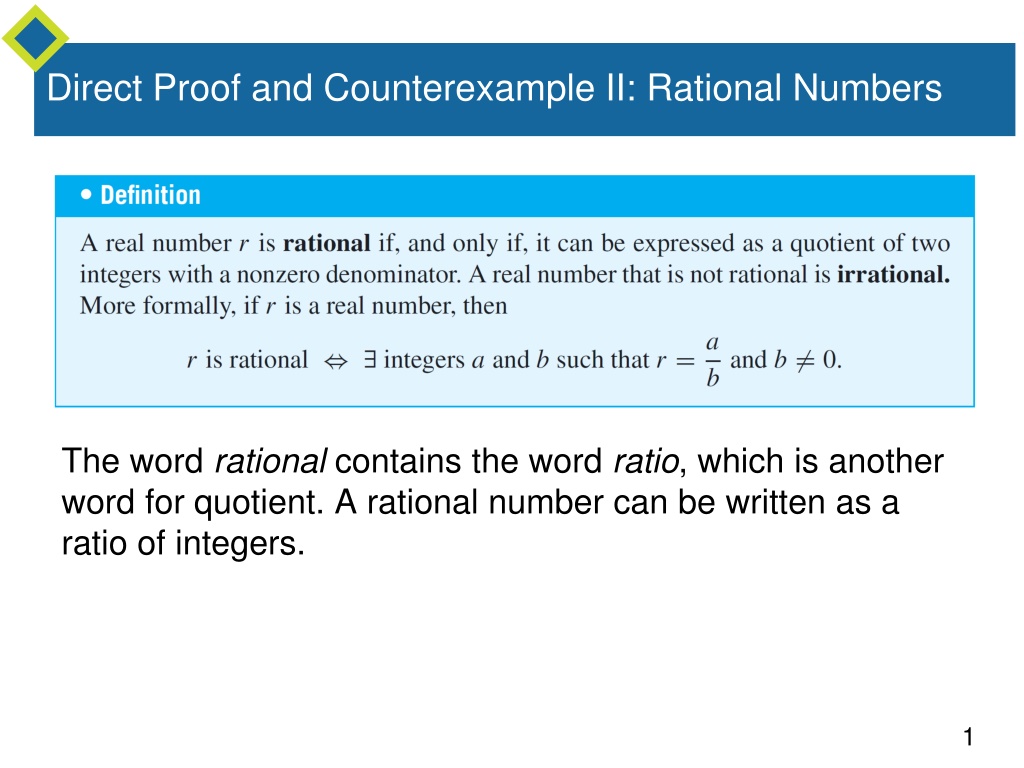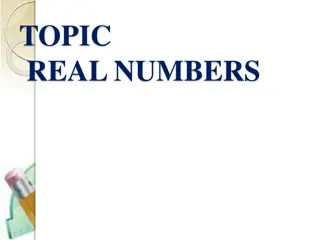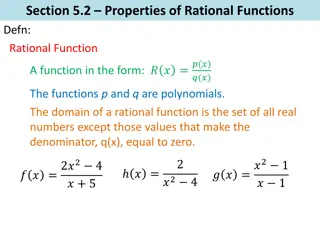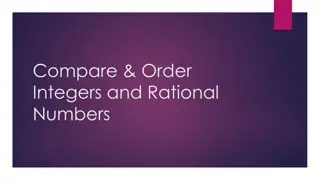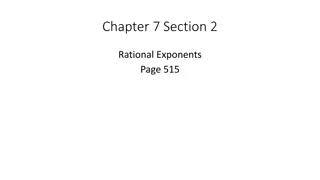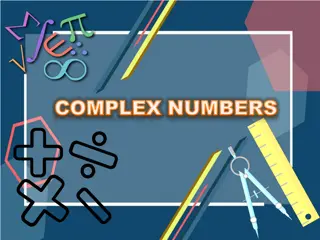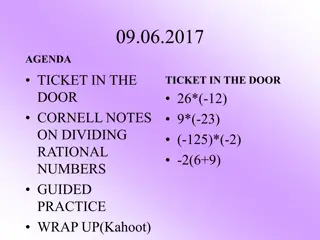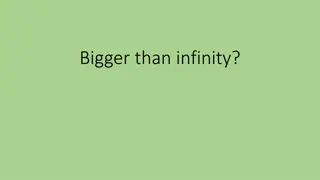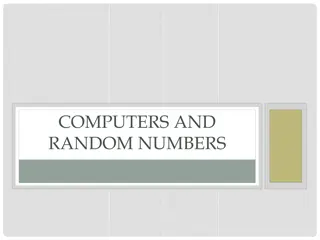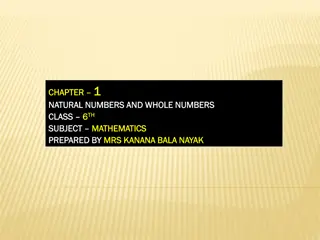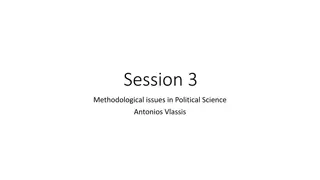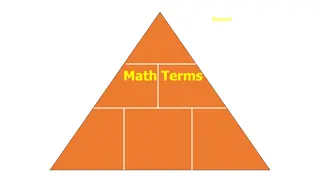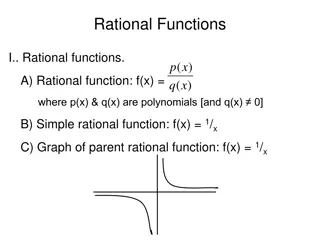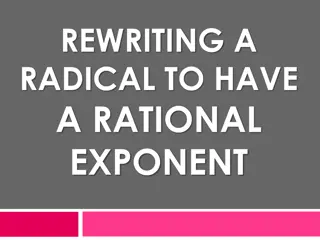Understanding Rational Numbers and Their Properties
Rational numbers are ratios of integers and can be expressed in various forms such as fractions and decimals. This content explains how to determine if a number is rational, provides examples, and proves properties of rational numbers like the closure under addition.
Uploaded on Sep 15, 2024 | 0 Views
Download Presentation

Please find below an Image/Link to download the presentation.
The content on the website is provided AS IS for your information and personal use only. It may not be sold, licensed, or shared on other websites without obtaining consent from the author. Download presentation by click this link. If you encounter any issues during the download, it is possible that the publisher has removed the file from their server.
E N D
Presentation Transcript
Direct Proof and Counterexample II: Rational Numbers The word rational contains the word ratio, which is another word for quotient. A rational number can be written as a ratio of integers. 1
Example 1 Determining Whether Numbers Are Rational or Irrational a. Is 10/3 a rational number? Yes, 10/3 is a quotient of the integers 10 and 3 and hence is rational. b. Is 5/39 a rational number? Yes, is a quotient of the integers 5 and 39 and hence is rational. c. Is 0.281 a rational number? Yes, 0.281 = 281/1000. d. Is 7 a rational number? Yes, 7 = 7/1. 2
Example 1 Determining Whether Numbers Are Rational or Irrational e. Is 0 a rational number? Yes, 0 = 0/1. f. Is 2/0 a rational number? No, 2/0 is not a number (division by 0 is not allowed). 3
Example 1 Determining Whether Numbers Are Rational or Irrational cont d h. Is 0.12121212 a rational number (where the digits 12 are assumed to repeat forever)? Yes. Let x= 0.12121212 Then, 99x = 100x x = 12.12121212 0.12121212 = 12 two nonzero integers and thus is a rational number. Therefore, 0.12121212 = 12/99, which is a ratio of 4
Example 1 Determining Whether Numbers Are Rational or Irrational cont d i. If m and n are integers and neither m nor n is zero, is (m + n)/mn a rational number? Yes, since m and n are integers, so are m + n and mn (because sums and products of integers are integers). Also mn 0 since m 0 and n 0. 5
Proving Properties of Rational Numbers The next example shows how to use the method of generalizing from the generic particular to prove a property of rational numbers. 6
Example 2 A Sum of Rationals Is Rational Prove that the sum of any two rational numbers is rational. Solution: Begin by mentally or explicitly rewriting the statement to be proved in the form ______, if ______ then ______. Formal Restatement: real numbers r and s, if r and s are rational then r + s is rational. Next ask yourself, Where am I starting from? or What am I supposing? The answer gives you the starting point, or first sentence, of the proof. 7
Example 2 Solution cont d Starting Point:Suppose r and s are particular but arbitrarily chosen real numbers such that r and s are rational; or, more simply, Suppose r and s are rational numbers. Then ask yourself, What must I show to complete the proof? To Show:r + s is rational. Finally ask, How do I get from the starting point to the conclusion? or Why must r + s be rational if both r and s are rational? The answer depends in an essential way on the definition of rational. 8
Example 2 Solution cont d Rational numbers are quotients of integers, so to say that r and s are rational means that It follows by substitution that 9
Example 2 Solution cont d You need to show that r + s is rational, which means that r + s can be written as a single fraction or ratio of two integers with a nonzero denominator. But the right-hand side of equation (4.2.1) in 10
Example 2 Solution cont d Is this fraction a ratio of integers? Yes. Because products and sums of integers are integers, ad + bc and bd are both integers. Is the denominator bd 0? Yes, by the zero product property (since b 0 and d 0). Thus r + s is a rational number. This discussion is summarized as follows: 11
Example 2 Solution cont d Proof: Suppose r and s are rational numbers. [We must show that r + s is rational.] Then, by definition of rational, r = a/b and s = c/d for some integers a, b, c, and d with b 0 and d 0. Thus 12
Example 2 Solution cont d Let p = ad + bc and q = bd. Then p and q are integers because products and sums of integers are integers and because a, b, c, and d are all integers. Also q 0 by the zero product property. Thus Therefore, r + s is rational by definition of a rational number. [This is what was to be shown.] 13
Deriving New Mathematics from Old In the future, when we ask you to prove something directly from the definitions, we will mean that you should restrict yourself to this approach. However, once a collection of statements has been proved directly from the definitions, another method of proof becomes possible. The statements in the collection can be used to derive additional results. 14
Example 3 Deriving Additional Results about Even and Odd Integers Suppose that you have already proved the following properties of even and odd integers: P1) The sum, product, and difference of any two even integers are even. P2) The sum and difference of any two odd integers are even. P3) The product of any two odd integers is odd. P4) The sum of any odd integer and any even integer is odd. 15
Example 3 Deriving Additional Results about Even and Odd Integers cont d Theorem: if a is any even integer and b is any odd integer, then ?2+?2+1 2 is an integer. Proof: Suppose a is any even integer and b is any odd integer. Then, 1. b2 is odd by P3 2. a2 is even by P1 3. a2 + b2 is odd by P4, applied to 1 and 2 4. a2 + b2 +1 is even by P2, applied to 3 5. k Z: a2 + b2 +1 = 2k by defn of even , applied to 4 6. k Z: (a2 + b2 +1)/2 = k 16
Deriving New Mathematics from Old A corollary is a statement whose truth can be immediately deduced from a theorem that has already been proved. For example, recall that we know Then it immediately follows that because the double of a number is just its sum with itself. 17
